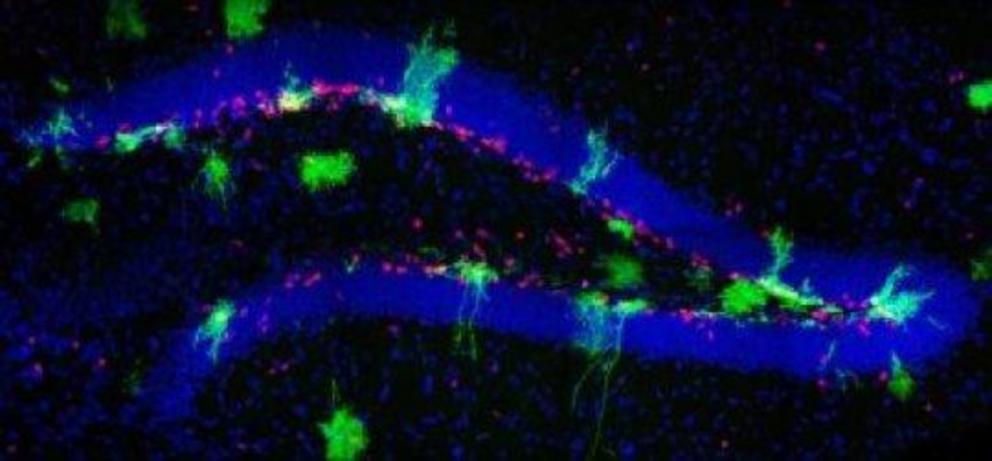Researchers discover the source of new neurons in brain's hippocampus
The dentate gyrus of mouse hippocampus at postnatal day 7, blue is nuclei marker, green is progeny of HOPX-expressing progenitor cells, and red is marker of cell proliferation.
Findings extend understanding of how a continuous supply of neurons throughout life is connected with learning and memory
Source:
University of Pennsylvania School of Medicine
Summary:
Researchers have shown, in mice, that one type of stem cell that makes adult neurons is the source of this lifetime stock of new cells in the hippocampus. These findings may help neuroscientists figure out how to maintain youthful conditions for learning and memory, and repair and regenerate parts of the brain after injury and aging.
FULL STORY
It was once believed that mammals were born with the entire supply of neurons they would have for a lifetime. However, over the past few decades, neuroscientists have found that at least two brain regions -- the centers of the sense of smell and the hippocampus, the seat of learning and memory -- grow new neurons throughout life.
Researchers from the Perelman School of Medicine at the University of Pennsylvania have shown, in mice, that one type of stem cell that makes adult neurons is the source of this lifetime stock of new cells in the hippocampus. Published this week in Cell, these findings may help neuroscientists figure out how to maintain youthful conditions for learning and memory, and repair and regenerate parts of the brain after injury and aging.
"We've shown for the first time, in mammals, that neurons in the dentate gyrus of the hippocampus grow and develop from a single population of stem cells, over an entire lifespan," said senior author Hongjun Song, PhD a professor of Neuroscience. "The new immature neurons are more flexible in making connections in the hippocampus compared to mature neurons, which is paramount for healthy learning, memory, and adjusting mood."
The researchers showed that the neural stem cells they found had a common molecular signature across the lifespan of the mice. They did this by labeling neural stem cells in embryos when the brain was still developing and following the cells from birth into adulthood. This approach revealed that new neural stem cells with their precursor's label were continuously making neurons throughout an animal's lifetime.
"This process is unique in the brain," said co-senior author Guo-li Ming, MD, PhD, a professor of Neuroscience. "In the hippocampus, these cells never stop replicating and contribute to the flexibility of the brain in mammals."
This capacity is called plasticity, which is the brain's ability to form new connections throughout life to compensate for injury and disease and to adjust in response to new input from the environment. Ming likens the process of new neuron growth in the hippocampus to adding new units into the circuitry of the brain's motherboard.
The teams' next steps will be to look for the same neural stem cells in other mammals, most importantly in humans, starting the search in post-mortem brain tissue, and to investigate how this population of neural stem cells are regulated.
This work was funded by the National Institutes of Health (P01NS097206, R37NS047344, R35NS097370, R01MH105128), EMBO, and the Swedish Research Council.
Journal Reference:
- Daniel A. Berg, Yijing Su, Dennisse Jimenez-Cyrus, Aneek Patel, Nancy Huang, David Morizet, Stephanie Lee, Reeti Shah, Francisca Rojas Ringeling, Rajan Jain, Jonathan A. Epstein, Qing-Feng Wu, Stefan Canzar, Guo-Li Ming, Hongjun Song, Allison M. Bond. A Common Embryonic Origin of Stem Cells Drives Developmental and Adult Neurogenesis. Cell, 2019; DOI: 10.1016/j.cell.2019.02.010

